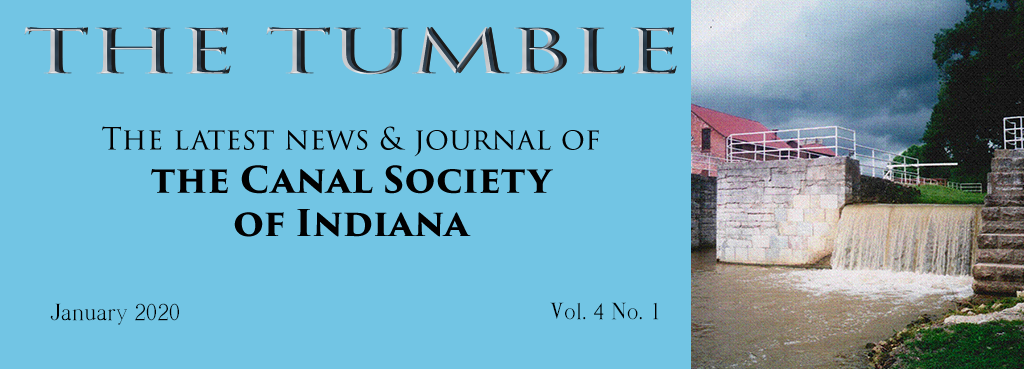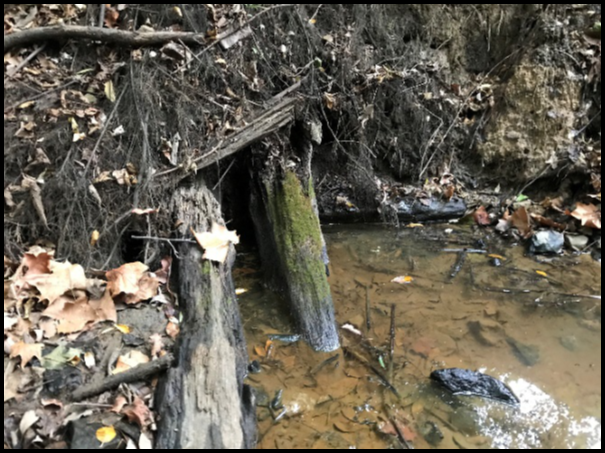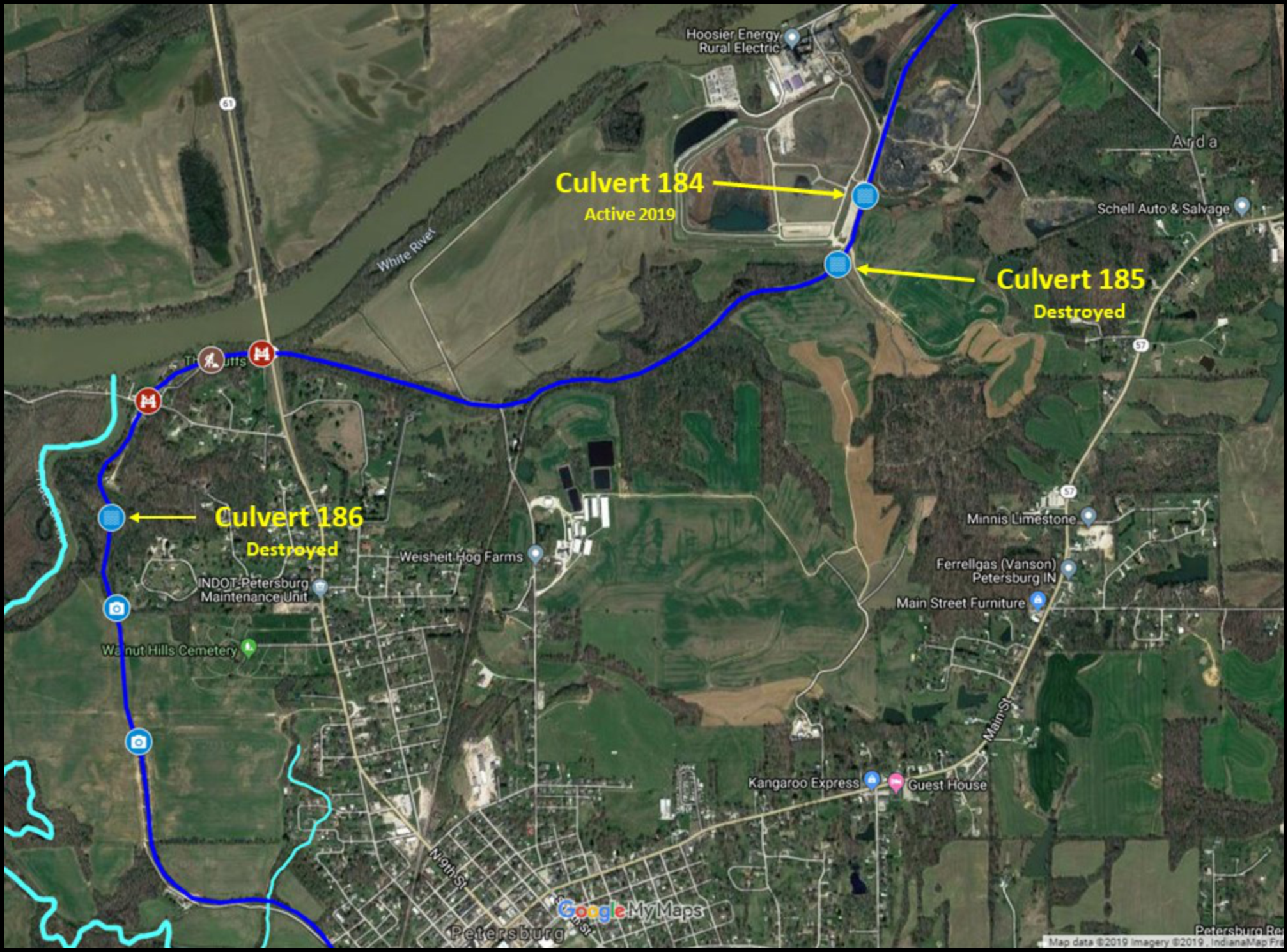Index:
Culvert Found in Pike County
On October 15, 2019, CSI member Preston Richardt was driving through Petersburg, Indiana, and decided to pay an acquaintance a visit in regards to the Wabash and Erie Canal that ran through the back portion of his farm. A claim was made that a culvert was still in use in the area; but before we get to far ahead in our story lets go back in time.
CSI member Preston Richardt is an amateur historian who lives in Gibson County and has studied the Wabash and Erie Canal since about the year 2000. He grew up in Warrick County hearing stories of the “old canal” east of his hometown of Elberfeld; Preston states, “like many Hoosiers I knew that it was there and some local lore about it but nothing concrete.” Preston did not study the canal in earnest until fellow CSI Board Member Dave Kurvach began asking questions about the canal and its location through Warrick County. It was at this point that the two made it a goal to map the canal and photograph as much of it as possible before it was lost. Dave began in Warrick County while Preston began researching Gibson County. Since that time the two have been able to GPS locate much of the canal path through these two counties and have located many structures’ previous locations. Some of them are still visible today.
Preston decided in early 2018 that, since Gibson County was mostly mapped and many of its features located, Pike County was the next logical location to continue his research and endeavors. In late winter Preston began his search of the canal in Pike County. With a basic idea of the canal’s path Preston visited the public library and the courthouse for records before exploring some known and some suspected locations of canal sites. “I strongly believe in obtaining permission to property prior to entry and that is what I was doing on that day as well,” Preston stated.
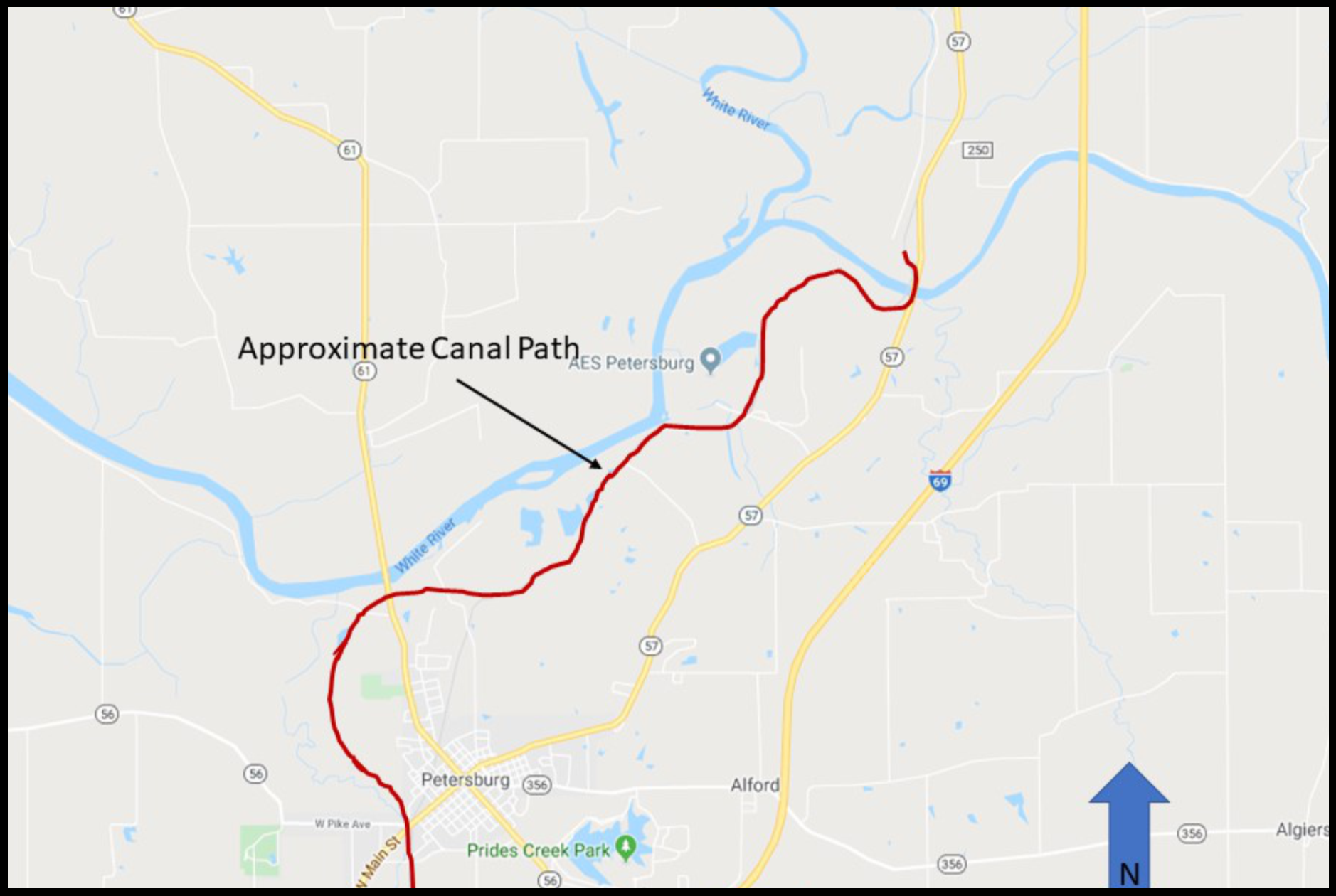 A section of the canal is known to traverse north and east of Petersburg prior to crossing the White River. But being unable to identify the canal’s location west and north of town, which has since been located and documented, Preston began looking at maps and talking to locals. They told him to talk to a local farmer who owned a large portion of the farmland north of town.
A section of the canal is known to traverse north and east of Petersburg prior to crossing the White River. But being unable to identify the canal’s location west and north of town, which has since been located and documented, Preston began looking at maps and talking to locals. They told him to talk to a local farmer who owned a large portion of the farmland north of town.
Preston went to the farm of Christopher Rudolph to inquire if he knew anything about the location of the canal that may or may not have been on his property. To Preston’s surprise Christopher was indeed very knowledgeable and seemed to have a passion for the canal as well. He explained where the canal was on his property and the location of the culverts. He stated that one of the culverts had been removed by the railroad and that the timbers had been dumped on his property. He in-turn collected the timbers, milled them and used them to line his living room wall. He also made a bench out of one of them.
Christopher also made the claim that there was still one working culvert on the back edge of his property. This really peaked an interest in Preston as the only known operating wooden culvert was 203, Buck Creek, in Gibson County. Unfortunately, the weather was not conducive for a visit to the location that day; however, this remained a priority for Preston to investigate.
As time passed and the farming season grew to a close in the autumn of 2018 Preston was unable to arrange the time with Christopher Rudolph to see the culvert. In December Dave Kurvach and Preston GPS mapped the canal along the west side of Petersburg to the Bluffs of the White River as described in the state reports.
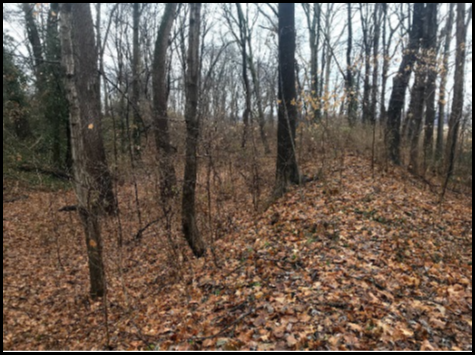 A 2.25-mile section of canal was GPS tagged and the site of Culvert 186 was located but nothing of the culvert was there. Once again, the weather was not going to allow them access to the “still operating” culvert.
A 2.25-mile section of canal was GPS tagged and the site of Culvert 186 was located but nothing of the culvert was there. Once again, the weather was not going to allow them access to the “still operating” culvert.
On October 15, 2019 Preston began GPS mapping portions of the canal in Daviess and Greene counties. With the location of the Newberry Dam being known and the water levels down Preston went to the site at the urging of Mr. Kurvach.
While in the area Preston visited many other locations. Traveling home, he crossed the White River bridge into Pike County and on a whim paid the Rudolph family a visit. As he figured, Christopher was out in the fields, but his son Tom remembered Preston and the two began to discuss access and the exact location of culvert. During this conversation Tom offered to take Preston to the culvert and the two proceeded to the site. What was found was truly astonishing!
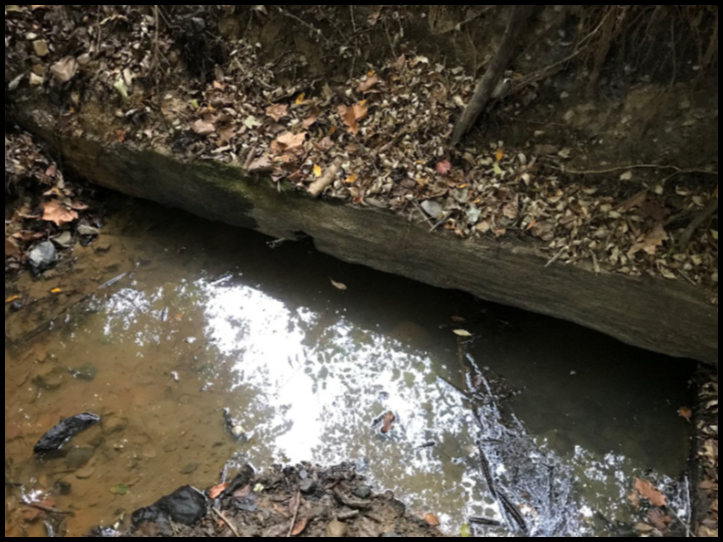
All this backstory has been told to present to you, the members Canal Society of Indiana, Culvert 184; an active wooden box culvert in Pike County, Indiana. It passes under the old canal (now a modern railroad). The south side of the culvert still has the original timbers, some of which have been removed but they are still on site. The north side of the culvert is made of concrete. It is believed the main body of the culvert is still intact. Water passes into the culvert from the south from the adjoining hillside.
At first Preston was not sure which culvert it was, but, thanks to modern technology, he carries digital copies of the audits with him and was able to access the 1853 report. This is what was utilized to identify the culvert number. The culvert according to the state report published in 1853 reads:
“Culvert 184. One space 8 by 2 feet clear. Length 142 feet. Top of culvert 14 1/4 feet below B.”
After reading the description Preston measured the open space and the length came to 8 foot clear and it sat approximately 18 feet below the railroad tracks, which were built atop the canal after it was filled with dirt.
No other culverts in the area had the measurements that fit the description and those taken at the site. Investigations to other possible culverts in the area are still ongoing.
Indiana Organizations: worked with organizations such as Carroll County Wabash & Erie Canal Association’s museum Archive Committee; Conner Prairie pioneer transportation in early Indiana.
Signage & Markers: Coordinated the installation of six CSI-sponsored site markers: Aboite Aqueduct No. 2, Eel River Aqueduct 10 and four Feeder dams at the Forks of Wabash Huntington, Lagro, Peru, and Pittsburg. Completion of the installations made possible because of the cooperation of local CSI members and others who should be members. Initial approvals received for signage to mark the St. Joseph River Feeder through Purdue University Fort Wayne’s athletic complex and Fort Wayne Parks River Greenway Trail at the historic site of the St. Mary’s Aqueduct No. 1. Research and text fro Delphi Canal Park’s Irish Labor Shanty marker.
What is happening to canal related sites queries? Typical projects include assisting folks such as rail fan researchers to locate Wabash Erie Canal sites such as St. Joseph River feeder line for trolley rail line interested group. Attempting to track down missing Indiana History Bureau markers such as Gronauer Lock now lost.
Books read: The Pioneers, David McCullough. Also, Early Immigrants of Cass Co, Ind Michael Stajduhar.
Ferris, Gary & Cassandra – Attended CSI spring tour
Finney, Margo – Attended CSI spring tour
Fledderjohann, Tom & Diane
We submitted articles and pictures about Ohio’s culvert being washed out. We attended CSI-CSO’s fall tour.
Foster, Rilla – Attended CSI-CSO fall tour
Goar, Lowell & Jerry – Attended CSI spring tour
Gooch, Susan – Attended CSI spring tour
Goughnour, Tom – Attended CSI spring tour and CSI-CSO fall tour
Hall, Webster – Attended CSI spring tour
Helbing, Bill – Attended CSI spring tour
Hess, Phyllis – Attended CSI spring tour and CSI-CSO fall tour, helped on tour logistics
Hillman, John – Whitewater Canal – CSI Director
I have a lead in Connersville that I am pursuing. The signs sponsored by CSI along the Whitewater Valley Railroad route are all in good shape and visible. The board meeting is at the busiest time for the railroad so I cannot attend. I talked about Whitewater Canal while on the train to Metamora.
Hite, Andy – Led CSI spring tour at Piqua, attended CSI-CSO fall tour
Hughes, William & Betty – Attended CSI-CSO fall tour
Jesse, Sue – Attended CSI spring tour and CSI-CSO fall tour, helped on tour logistics
Jones, Troy – Submitted postcard with canal stamp and canal cancellation for “The Tumble”
Koehler, Jeff – W & E Canal – Center Point – CSI Director
Presented four programs about canals
Kroger, Patty – Attended CSI-CSO fall tour
Kurvach, David – W & E Canal – Warrick County – CSI Director
Researched and wrote two articles for “The Tumble” complete with pictures of what remains of the W&E Canal in Warrick county. He received two canal signs for Warrick county and is working on getting them erected. He is helping plan the 2020 spring tour through his county.
Ligget, Sam – W&E Canal -Terre Haute – CSI Director
My wife JoAnn and I attended the CSI spring canal tour and the fall CSI-CSO canal tour. I wrote 2 articles for “The Tumble.”
I worked on getting a Canal Society of Indiana sign posted at the intersection of highway 46 and the Cross-cut Canal just east of Riley, Indiana. The sign was approved by INDOT but we had to wait for a work order for it to be posted. Working with INDOT has been an education! It was finally installed in October 2019.
I attended the Vigo County Parks and Recreation Department’s 5-year planning meeting. The new director is open to doing something with the Riley Lock. The timbers saved from Aqueduct 151 have a new temporary home. A volunteer has built a protective roof over the timbers. They are located in the pioneer village at Fowler Park where people can see them. I have provided information about these timbers to the Vigo Co. Parks and Recreation for a display during the annual Pioneer Days Festival at the park.
“Destiny of the Republic” by Candice Millard is good reading about the assassination of President James Abram Garfield. “From Canal Boy to President” by Horatio Alger is cited as a reference book by the author. Before reading Millard’s book, I didn’t know we had a president that had a working connection to canals.
McCain, Dan – W & E Canal – Delphi – CSI Director
Served as president of the Carroll County Wabash & Erie Canal Association and was involved with all its activities, submitted 10 articles with pictures about Canal Park in Delphi for “The Tumble.” Hosted CSI Directors meeting.
McKarns, Bill & Pauline – Attended CSI-CSO fall tour
Mattheis, Jerry & Phyllis – Whitewater Canal – Cambridge City – CSI Directors
Phyllis assisted Mike Morthorst with planning for the fall tour of the National Road in this area. Seeing the Milton culvert and a lock was on the agenda. Jerry and Phyllis also did some sprucing up of the 3rd floor canal museum in the Vinton House in preparation of tour visitors.
In Hagerstown, a bridge on Teetor Road is being replaced. The publicity says it was over the “old Whitewater Canal.” Actually it was over the feeder for the Hagerstown extension to the Whitewater Canal. The canal boat turnaround and landing were at the foot of South Perry Street a couple of blocks southwest of the bridge. The old bridge had 60 years of service, concrete abutments, steel support beams, and a concrete deck The new bridge is a three-sided concrete box culvert, spanning 35 feet across the feeder canal. It was to be completed in September.
Phyllis wrote an article for “The Tumble.”
Migliore, Brian – Visited Neptune’s Staircase, the longest staircase lock in Britain, on the Caledonian Canal at Banavie.
Morris, Dr. Ron – Attended CSI spring tour, provided Governor Oliver P. Morton’s home for meals for the CSI spring tour and the CSI-CSO fall tour, worked with Ball State students on the CSI website and “The Tumble”
Morthorst, Mike – Cincinnati – CSI Director
Served as CSI vice-president, planned CSI-CSO fall tour, acted as docent, and wrote tour guide book, served as secretary for Whitewater Canal Trails organization, edited CSO newsletter
Morthorst, Tom – Attended the CSI-CSO fall tour
Newhardt, Dave – Attended the CSI-CSO fall tour
Petrie, Ron & Corinne – Attended the CSI-CSO fall tour
Powers, Cynthia – W & E Canal – Ft. Wayne/Ossian – CSI Director
Served as CSI treasurer and paid bills, wrote an article for “The Tumble”
Renwick, Mark – Attended CSI-CSO fall tour
Richardt, Preston – Spoke to over 100 people at the Patoka River Wildlife Refuge Appreciation Day about the canal and aqueduct at Dongola and passed out CSI materials, built a replica of the W & E aqueduct over Patoka River No. 17
Riley, Mike – Served as American Canal Society president – Attended CSI-CSO fall tour
Rozick, Don & Kathleen – Attended CSI-CSO fall tour
Schmidt, Bob – W & E Canal – Ft. Wayne – CSI Director
Served as CSI president; planned CSI spring tour, arranged for train trip, contacted museums, etc.; helped with CSI-CSO fall tour; took pictures for “The Tumble” on both tours; planned CSI Board of Directors Meeting; kept CSI financial records and prepared financial statement; filed not-for-profit state and federal forms; wrote three articles for “The Tumble”; spoke about CSI and canals twice; arranged to have canal signs made, picked them up, and delivered them to Gibson county, Allen county, and Vigo county; worked with Ball State students for CSI website creating a map of Indiana’s canals with structures by county, pictures, and documents; developed mileage and statistical data: prepared data about canal officials, dams and feeders, etc. for website; answered canal questions and mailed material to several people
Schmidt, Carolyn – W & E Canal – Ft. Wayne – CSI Director
Co-ordinator for “The Tumble” and wrote 30 articles for it; prepared CSI Board of Directors meeting agenda and year end report booklet, purchased lunch for the directors meeting, attended CSI spring and CSI-CSO fall tours, prepared tour guide for spring tour, made name tags for tour and director’s meeting, collected materials for tour goodie bags, ordered meals, etc; compiled a 190 page book of newspaper clippings about canals and printed it; answered E-mailed questions about canals
Severt, Jill – Attended CSI-CSO fall tour
Sheldon, Kay – Attended CSI-CSO fall tour, Served as tour treasurer
Simerman, Sue – W & E Canal – Ossian – CSI Director
My husband, Steve, and I visited Grant’s Canal at Vicksburg, Mississippi. I took photos and wrote an article. We went on the CSI spring tour, visited the Whitewater Canal and took photos. We attended the CSI-CSO fall tour. I submitted photos for “The Tumble” from both tours.
June was a busy month for us. We visited the Miami and Erie Canal, Independence Dam, and Grand Rapids in Ohio and walked along the Gilead Canal. We made a stop at Delphi, Indiana for the Wabash and Erie Canal and at Lagro, Indiana where we took photos and looked at all of the work that is being done to make the town more attractive for river walkers and canoe users as well as businesses and new residents.
I passed out a few of our Canal Society of Indiana cards, took notes and wrote up the secretary’s report at the October 2018 board of director’s meeting, and was in charge of the nominations for the CSI annual spring business meeting. I attended the CSI Board of Directors meeting.
Smith, Mark – I submitted two articles and pictures for “The Tumble.”
Smith, Warren & Judy – Attended CSI spring tour
Sowards, Neil
I found pictures, postcards, and other canal related material on E-Bay and submitted them for “The Tumble.” My wife Diana and I attended the CSI spring tour.
Starbuck, Mary – Attended CSI-CSO fall tour
Stirm, Brian – W & E Canal – Delphi – CSI Director
My two 2019 events have been giving guided tours of W & E Canal Park with the Trolley during the Canal Days Fourth of July festival (about 8 of them, 40 minute tours, averaging 15 passengers each) and leading a driving tour of Carroll County with highlights of the Canal towpath in the Carrollton area. This event was during the National Packard Automotive Club convention in July. We had about 25 people on the Trolley and about 20 cars following us. We did lunch at Canal Park and all participants took “Delphi” Canal Boat rides (3 boat trips). It turned out to be a great day for canalling in Delphi and hopefully this national audience of like minded historic automotive participants will take the message back home with them.
Teeters, Alice – Attended CSI-CSO fall tour
Timmers, Frank & Mary – Attended CSI spring tour
Turner, Larry – Attended CSI-CSO fall tour
Williams, Steve – W & E Canal – Roanoke – CSI Director
I submitted an article for “The Tumble” and my wife Sharon and I attended the CSI-CSO fall tour and the CSI Board of Directors meeting.
Winchell, Linda – Attended CSI spring tour, made donation to Canal Locator Fund
Woods, Terry – Submitted an article for “The Tumble”

